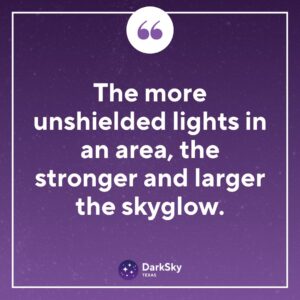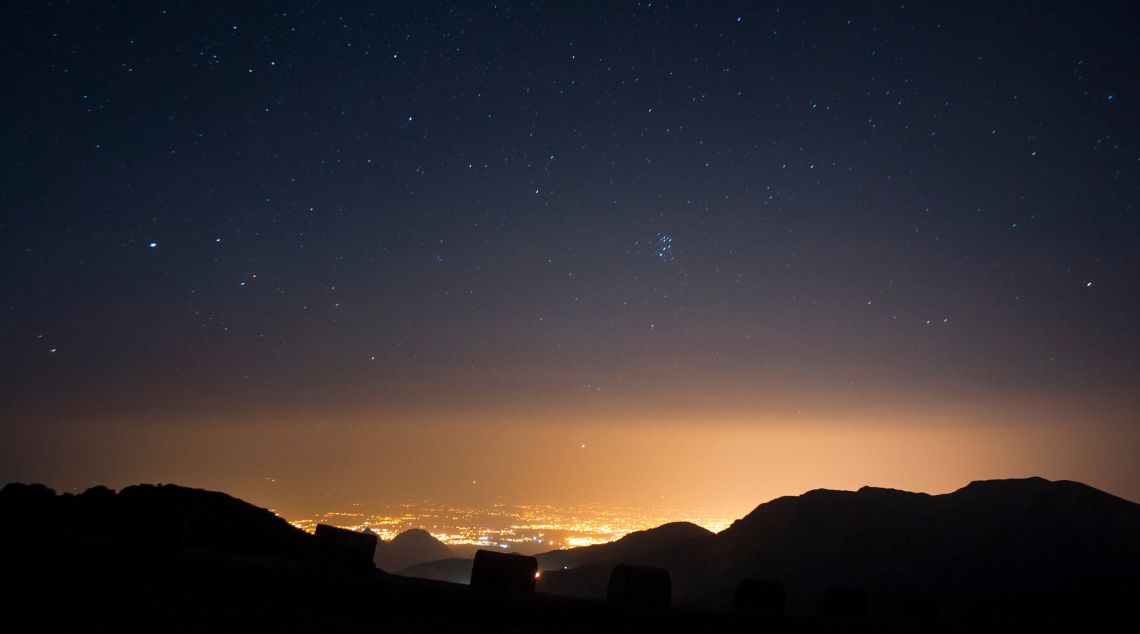When we try to imagine something eternal and immutable, our minds head straight for the abstract: the passage of time, high ideals, or divinity. It’s much harder to think of physical things that can last forever!
Yet, the night skies have earned this rare privilege. We’ve been studying the cycles and shapes formed by the night stars for millennia, and it’s rare to think that we are looking at the same constellations as the ancient Sumerians or Greeks.
For the first time in history, the night skies no longer look the same way they always have. The stars behind may be the same, but light pollution, specifically skyglow, has increased the night sky brightness, making the stars appear dimmer or disappear altogether. Today, we will look at skyglow, the fundamental cause of this phenomenon.
What Is Skyglow?
For scientists, skyglow means “an increase in the apparent brightness of the sky.” For most of us, skyglow looks like a big dome of light covering most cities and towns and the infrastructure that connects them. This phenomenon is further exemplified by the ‘light dome,’ a visible effect of skyglow caused by artificial light sources illuminating the night sky, representing the integrated brightness of the entire night sky over populated areas.
Areas affected by skyglow will show a grayish-white or orange sky instead of remaining pitch-black. In extreme cases, it may even look slightly yellow—think of the halo around a full moon, just covering the entire sky in an area. This glow makes it harder to recognize and distinguish the stars and planets or to not see them at all.
What Causes Skyglow?
Skyglow is created by the combined effect of all excess uplight in an area. This artificial light was either directed upward or reflected upward. Either way, it travels up and gets dispersed into the air, where the light emitted from various sources combine to become skyglow.
Most of the time, uplight is the result of poorly planned light installations: when they’re not pointing at something that needs to be illuminated or protected with a shield or screen, artificial light scatters for miles. If the light rays are not initially directed upward, they may instead fall on an object below the light, where certain types of surfaces can reflect them to the sky.
That said, it’s important to remember that a single misdirected streetlight will generally not create significant skyglow. Unlike other types of light pollution, such as glare, skyglow cannot be traced to a single source. Instead, it is created from the cumulative effects of dozens, hundreds, or thousands of:
- Indoor lights that escape through windows
- Street lights without a recessed light source, especially white LED street lights
- Unattended patio lights and torches
- Unshielded stadium lights
- LED billboards and signs
- Parking lot lights
- So-called security lighting that fails to follow the 5 Principles of Responsible Outdoor Lighting

However small each one may be, their rays travel and contribute to the pervasive skyglow that covers much of our world. It’s death by a thousand papercuts.
Factors Worsening Skyglow: Measuring Night Sky Brightness
The more unshielded light sources in an area, the stronger and larger the skyglow.
However, skyglow is also influenced by factors beyond human influence, which can significantly impair visibility from one day to the next.
Skyglow is more visible when there’s anything in the air that will reflect the light as it scatters. This includes:
- Particulate dust or sand
- Air pollution
- Water droplets (humidity)
- Fog or mist
- The Earth’s atmosphere plays a crucial role in reflecting and scattering light from various sources, including ground-based lights, space objects like satellites and space debris, and natural light, intensifying the skyglow effect.
Skyglow’s Effects on Increasing Light Pollution
Skyglow contributes to the overall levels of light pollution in an area, and it shares many of the same effects. These impact humans and wildlife alike:
Many species of birds and sea turtles instinctively follow the moon’s glow to guide their migration patterns. Skyglow makes this halo less noticeable, causing them to get lost,
Insects and small animals are also attracted to areas with more light. As skyglow attracts them towards cities and suburbs, they find their way onto a highway—or a “pest control” initiative!
Skyglow may also interfere with trees’ ability to detect seasonal changes and increase their chance of being killed by an early frost.
Human health is negatively impacted when surrounded with the light levels present in an area immersed in skyglow.
In addition, one group of humans is seeing their lives upended by skyglow: astronomers. As Skyglow’s hazy lights obscure the stars, astronomers now need to move their observation stations further away from civilization,
By increasing artificial brightness, Skyglow diminishes the visibility of natural light sources like stars across the entire night sky.
So, how far do they have to go?
How bad is it?
Currently, skyglow affects 23% of the world’s land area. In addition, the Milky Way is no longer visible in over 50% of the continental United States and 88% of Europe.
Moreover, this sizable chunk of the world continues to grow by as much as 10% yearly. The DarkSky International is actively working to combat the growth of Skyglow through education and awareness initiatives.
Can We Reverse It?
As skyglow is a cumulative phenomenon, diminishing it requires coordinated, cumulative forces. What are the most important measures? Lowering the amount of up-facing or unshielded outdoor lighting as much as possible is crucial for reducing the overall ‘sky brightness’ caused by skyglow.
To do this, the same principles for responsible outdoor lighting that DarkSky Texas promotes can make a sizable difference. However, they need to be applied consistently by private landowners and government institutions alike.
We need to ensure skyglow (and light pollution overall) is recognized as addressed by local zoning laws and construction codes. This requires a massive educational campaign: lawmakers and citizens must understand the effects of skyglow and the importance of combating it to reduce sky brightness.
This is why DarkSky Texas directs much of its efforts to educational and awareness events. Your contributions and allyship can be the turning point in rescuing our night skies.


